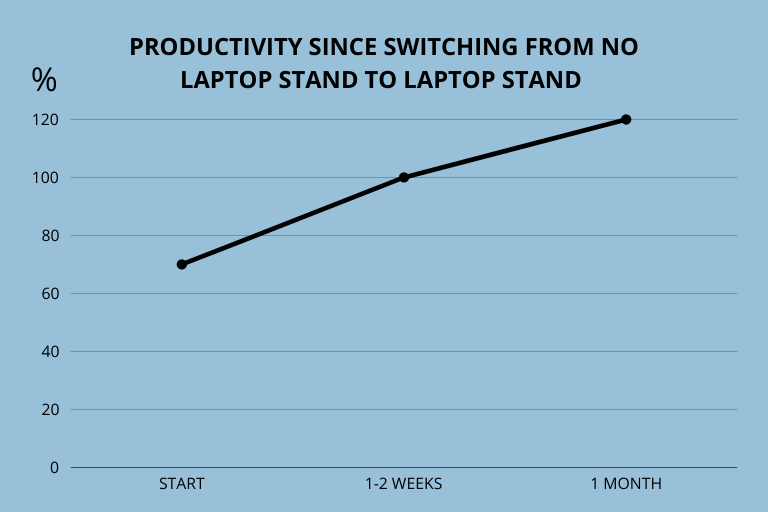Laptop stands have become a go-to accessory for many remote workers and digital nomads, promising improved posture and enhanced productivity. But are there only pros to using them? Today, we’re diving into some often-overlooked disadvantages of laptop stand.
Also, read out article on how to use a laptop stand for an easy setup, and to get the best results if you decide to get one.
Table of Contents
1. Can Be Troublesome To Bring With You
First and foremost, it can be a bit difficult and annoying to bring your laptop stand with you everywhere you go. It’s easy to forget it and you can easily lose it, especially if it’s small.
A big laptop stand can be hard to fit in your bag and it may be hard to find surfaces for setup. This can be avoided if you just choose to buy a small and portable laptop stand like the Nextstand K7 that can fold itself to take minimal space.

Another possible drawback when traveling with a laptop stands is that you may also have to bring a keyboard. There are many laptop stands that you don’t need an external keyboard for, but there are also many that you need one for. Take this into consideration when choosing a laptop stand.
2. One Size Doesn’t Fit All
Most laptop stands don’t fit all different sizes of laptops. Therefore you may need to have several laptop stands for different laptops, or buy a laptop stand that’s a little bit more expensive and fits all sizes.
Cheaper and smaller portable laptop stands usually can’t hold as big laptops as non-portable and more expensive ones.
The laptop ventilation system on all laptops might not be a good match for every laptop stand. Some laptop stands can hinder some laptop models’ ventilation systems from working and make them overheat.
3. Can Be a Bit Expensive
The price of a laptop riser can be a disastrous problem for students or anybody who’s trying to save money. Well, high-quality laptop holders can indeed be pricey.

But, you don’t need to buy an expensive one in the beginning. You could start with a cheaper one (there are many under $20) and then buy a more expensive one later if you want to.
It can cost you some extra bucks if you buy a laptop stand that needs an external keyboard to use it, but that’s your own choice if you do.
After months of using your laptop stand every day for hours, you’ll maybe need to replace something because of wear. You may even need to buy a new one. This of course adds more cost to it all, but I think that’s something you got to consider when buying anything new.
4. Stability Concerns: Wobbles and Worries
A cheap and small laptop stand can be wobbly and there’s a risk of it falling from the stand and breaking. This is one of the biggest disadvantages of laptop stand use for smaller plastic stands.

When typing on the laptop while it’s on the laptop holder, shaking can occur. Make sure your laptop falls safely if it happens to slip of the stand. Don’t sit with your laptop stand on a narrow table where your laptop can easily fall on the floor.
5. Wrists Pain From Writing on a Laptop Stand
One of the laptop stand disadvantages is potential wrist pain. Wrist pains only apply to you who write on you laptop while it’s on the stand.

On a laptop stand the keyboard is elevated. Consequently, you need to have your wrist in an unnatural and uncomfortable position. This can cause you pain. Get some tips on how to set up your laptop stand the correct way with an external keyboard if that’s what you want to do with our article on how to use a laptop stand.
6. Aesthetic Impact: Form vs. Function
To a plentiful people laptop stands aren’t really that aesthetically pleasing to the eye. They think it brings too much clutter to the workspace and prefer to not use one.

Image credit: charlesdeluvio/Unsplash
The laptop stand may not fit into the rest of the existing office decor. Some laptop stands need additional cables and cords, which brings even more clutter.
Personally, I like a minimalistic desk, but I still use a laptop stand when working with a laptop because of the posture benefits.
7. Adaptation Period: The Learning Curve
In the beginning days of using a laptop stand my productivity went down a few steps. Getting used to writing on the laptop while it’s on the stand, and getting comfortable with your new working position can take a little time.

For long-time laptop users this can be extra hard, but it shouldn’t be that big of a burden. As I said it only took a few days for me to get my productivity back, and then beyond my previous levels.
FAQ
Q1: Do laptop stands really cause neck strain?
A: They can, especially if not set up correctly. Elevating your laptop screen might cause you to tilt your head back, potentially leading to neck strain over time. It’s crucial to adjust the stand height for optimal viewing angles.
Q2: How can I tell if a laptop stand is compatible with my device?
A: Check the stand’s specifications for supported laptop sizes and weights. Also, consider your laptop’s ventilation system and port locations to ensure they won’t be obstructed by the stand.
Q3: Can laptop stands damage my device?
A: While rare, there’s a potential risk of damage if your laptop falls from an unstable stand. Additionally, some stands might interfere with your laptop’s cooling system if not designed properly.
Q4: Are there alternatives to laptop stands that offer similar benefits?
A: Yes! Alternatives include adjustable desks, laptop cooling pads, or even DIY solutions like using books or boxes to elevate your laptop. Each option has its own pros and cons.
Q5: How often should I clean my laptop stand?
A: Aim to clean your laptop stand at least once a month, or more frequently if you use it in dusty environments. Regular cleaning helps maintain its functionality and hygiene.
